- Dutch
- Frisian
- Saterfrisian
- Afrikaans
-
- Phonology
- Segment inventory
- Phonotactics
- Phonological processes
- Phonology-morphology interface
- Word stress
- Primary stress in simplex words
- Monomorphemic words
- Diachronic aspects
- Generalizations on stress placement
- Default penultimate stress
- Lexical stress
- The closed penult restriction
- Final closed syllables
- The diphthong restriction
- Superheavy syllables (SHS)
- The three-syllable window
- Segmental restrictions
- Phonetic correlates
- Stress shifts in loanwords
- Quantity-sensitivity
- Secondary stress
- Vowel reduction in unstressed syllables
- Stress in complex words
- Primary stress in simplex words
- Accent & intonation
- Clitics
- Spelling
- Morphology
- Word formation
- Compounding
- Nominal compounds
- Verbal compounds
- Adjectival compounds
- Affixoids
- Coordinative compounds
- Synthetic compounds
- Reduplicative compounds
- Phrase-based compounds
- Elative compounds
- Exocentric compounds
- Linking elements
- Separable complex verbs (SCVs)
- Gapping of complex words
- Particle verbs
- Copulative compounds
- Derivation
- Numerals
- Derivation: inputs and input restrictions
- The meaning of affixes
- Non-native morphology
- Cohering and non-cohering affixes
- Prefixation
- Suffixation
- Nominal suffixation: person nouns
- Conversion
- Pseudo-participles
- Bound forms
- Nouns
- Nominal prefixes
- Nominal suffixes
- -aal and -eel
- -aar
- -aard
- -aat
- -air
- -aris
- -ast
- Diminutives
- -dom
- -een
- -ees
- -el (nominal)
- -elaar
- -enis
- -er (nominal)
- -erd
- -erik
- -es
- -eur
- -euse
- ge...te
- -heid
- -iaan, -aan
- -ief
- -iek
- -ier
- -ier (French)
- -ière
- -iet
- -igheid
- -ij and allomorphs
- -ijn
- -in
- -ing
- -isme
- -ist
- -iteit
- -ling
- -oir
- -oot
- -rice
- -schap
- -schap (de)
- -schap (het)
- -sel
- -st
- -ster
- -t
- -tal
- -te
- -voud
- Verbs
- Adjectives
- Adverbs
- Univerbation
- Neo-classical word formation
- Construction-dependent morphology
- Morphological productivity
- Compounding
- Inflection
- Inflection and derivation
- Allomorphy
- The interface between phonology and morphology
- Word formation
- Syntax
- Preface and acknowledgements
- Verbs and Verb Phrases
- 1 Characterization and classification
- 2 Projection of verb phrases I:Argument structure
- 3 Projection of verb phrases II:Verb frame alternations
- Introduction
- 3.1. Main types
- 3.2. Alternations involving the external argument
- 3.3. Alternations of noun phrases and PPs
- 3.3.1. Dative/PP alternations (dative shift)
- 3.3.1.1. Dative alternation with aan-phrases (recipients)
- 3.3.1.2. Dative alternation with naar-phrases (goals)
- 3.3.1.3. Dative alternation with van-phrases (sources)
- 3.3.1.4. Dative alternation with bij-phrases (possessors)
- 3.3.1.5. Dative alternation with voor-phrases (benefactives)
- 3.3.1.6. Conclusion
- 3.3.1.7. Bibliographical notes
- 3.3.2. Accusative/PP alternations
- 3.3.3. Nominative/PP alternations
- 3.3.1. Dative/PP alternations (dative shift)
- 3.4. Some apparent cases of verb frame alternation
- 3.5. Bibliographical notes
- 4 Projection of verb phrases IIIa:Selection of clauses/verb phrases
- 5 Projection of verb phrases IIIb:Argument and complementive clauses
- Introduction
- 5.1. Finite argument clauses
- 5.2. Infinitival argument clauses
- 5.3. Complementive clauses
- 6 Projection of verb phrases IIIc:Complements of non-main verbs
- 7 Projection of verb phrases IIId:Verb clusters
- 8 Projection of verb phrases IV: Adverbial modification
- 9 Word order in the clause I:General introduction
- 10 Word order in the clause II:Position of the finite verb (verb-first/second)
- 11 Word order in the clause III:Clause-initial position (wh-movement)
- Introduction
- 11.1. The formation of V1- and V2-clauses
- 11.2. Clause-initial position remains (phonetically) empty
- 11.3. Clause-initial position is filled
- 12 Word order in the clause IV:Postverbal field (extraposition)
- 13 Word order in the clause V: Middle field (scrambling)
- 14 Main-clause external elements
- Nouns and Noun Phrases
- 1 Characterization and classification
- 2 Projection of noun phrases I: complementation
- Introduction
- 2.1. General observations
- 2.2. Prepositional and nominal complements
- 2.3. Clausal complements
- 2.4. Bibliographical notes
- 3 Projection of noun phrases II: modification
- Introduction
- 3.1. Restrictive and non-restrictive modifiers
- 3.2. Premodification
- 3.3. Postmodification
- 3.3.1. Adpositional phrases
- 3.3.2. Relative clauses
- 3.3.3. Infinitival clauses
- 3.3.4. A special case: clauses referring to a proposition
- 3.3.5. Adjectival phrases
- 3.3.6. Adverbial postmodification
- 3.4. Bibliographical notes
- 4 Projection of noun phrases III: binominal constructions
- Introduction
- 4.1. Binominal constructions without a preposition
- 4.2. Binominal constructions with a preposition
- 4.3. Bibliographical notes
- 5 Determiners: articles and pronouns
- Introduction
- 5.1. Articles
- 5.2. Pronouns
- 5.3. Bibliographical notes
- 6 Numerals and quantifiers
- 7 Pre-determiners
- Introduction
- 7.1. The universal quantifier al 'all' and its alternants
- 7.2. The pre-determiner heel 'all/whole'
- 7.3. A note on focus particles
- 7.4. Bibliographical notes
- 8 Syntactic uses of noun phrases
- Adjectives and Adjective Phrases
- 1 Characteristics and classification
- 2 Projection of adjective phrases I: Complementation
- 3 Projection of adjective phrases II: Modification
- 4 Projection of adjective phrases III: Comparison
- 5 Attributive use of the adjective phrase
- 6 Predicative use of the adjective phrase
- 7 The partitive genitive construction
- 8 Adverbial use of the adjective phrase
- 9 Participles and infinitives: their adjectival use
- 10 Special constructions
- Adpositions and adpositional phrases
- 1 Characteristics and classification
- Introduction
- 1.1. Characterization of the category adposition
- 1.2. A formal classification of adpositional phrases
- 1.3. A semantic classification of adpositional phrases
- 1.3.1. Spatial adpositions
- 1.3.2. Temporal adpositions
- 1.3.3. Non-spatial/temporal prepositions
- 1.4. Borderline cases
- 1.5. Bibliographical notes
- 2 Projection of adpositional phrases: Complementation
- 3 Projection of adpositional phrases: Modification
- 4 Syntactic uses of the adpositional phrase
- 5 R-pronominalization and R-words
- 1 Characteristics and classification
- Phonology
-
- General
- Phonology
- Segment inventory
- Phonotactics
- Phonological Processes
- Assimilation
- Vowel nasalization
- Syllabic sonorants
- Final devoicing
- Fake geminates
- Vowel hiatus resolution
- Vowel reduction introduction
- Schwa deletion
- Schwa insertion
- /r/-deletion
- d-insertion
- {s/z}-insertion
- t-deletion
- Intrusive stop formation
- Breaking
- Vowel shortening
- h-deletion
- Replacement of the glide w
- Word stress
- Clitics
- Allomorphy
- Orthography of Frisian
- Morphology
- Inflection
- Word formation
- Derivation
- Prefixation
- Infixation
- Suffixation
- Nominal suffixes
- Verbal suffixes
- Adjectival suffixes
- Adverbial suffixes
- Numeral suffixes
- Interjectional suffixes
- Onomastic suffixes
- Conversion
- Compositions
- Derivation
- Syntax
- Verbs and Verb Phrases
- Characteristics and classification
- Unergative and unaccusative subjects
- Evidentiality
- To-infinitival clauses
- Predication and noun incorporation
- Ellipsis
- Imperativus-pro-Infinitivo
- Expression of irrealis
- Embedded Verb Second
- Agreement
- Negation
- Nouns & Noun Phrases
- Classification
- Complementation
- Modification
- Partitive noun constructions
- Referential partitive constructions
- Partitive measure nouns
- Numeral partitive constructions
- Partitive question constructions
- Nominalised quantifiers
- Kind partitives
- Partitive predication with prepositions
- Bare nominal attributions
- Articles and names
- Pronouns
- Quantifiers and (pre)determiners
- Interrogative pronouns
- R-pronouns
- Syntactic uses
- Adjective Phrases
- Characteristics and classification
- Complementation
- Modification and degree quantification
- Comparison by degree
- Comparative
- Superlative
- Equative
- Attribution
- Agreement
- Attributive adjectives vs. prenominal elements
- Complex adjectives
- Noun ellipsis
- Co-occurring adjectives
- Predication
- Partitive adjective constructions
- Adverbial use
- Participles and infinitives
- Adposition Phrases
- Characteristics and classification
- Complementation
- Modification
- Intransitive adpositions
- Predication
- Preposition stranding
- Verbs and Verb Phrases
-
- General
- Morphology
- Morphology
- 1 Word formation
- 1.1 Compounding
- 1.1.1 Compounds and their heads
- 1.1.2 Special types of compounds
- 1.1.2.1 Affixoids
- 1.1.2.2 Coordinative compounds
- 1.1.2.3 Synthetic compounds and complex pseudo-participles
- 1.1.2.4 Reduplicative compounds
- 1.1.2.5 Phrase-based compounds
- 1.1.2.6 Elative compounds
- 1.1.2.7 Exocentric compounds
- 1.1.2.8 Linking elements
- 1.1.2.9 Separable Complex Verbs and Particle Verbs
- 1.1.2.10 Noun Incorporation Verbs
- 1.1.2.11 Gapping
- 1.2 Derivation
- 1.3 Minor patterns of word formation
- 1.1 Compounding
- 2 Inflection
- 1 Word formation
- Morphology
- Syntax
- Adjectives and adjective phrases (APs)
- 0 Introduction to the AP
- 1 Characteristics and classification of APs
- 2 Complementation of APs
- 3 Modification and degree quantification of APs
- 4 Comparison by comparative, superlative and equative
- 5 Attribution of APs
- 6 Predication of APs
- 7 The partitive adjective construction
- 8 Adverbial use of APs
- 9 Participles and infinitives as APs
- Nouns and Noun Phrases (NPs)
- 0 Introduction to the NP
- 1 Characteristics and Classification of NPs
- 2 Complementation of NPs
- 3 Modification of NPs
- 3.1 Modification of NP by Determiners and APs
- 3.2 Modification of NP by PP
- 3.3 Modification of NP by adverbial clauses
- 3.4 Modification of NP by possessors
- 3.5 Modification of NP by relative clauses
- 3.6 Modification of NP in a cleft construction
- 3.7 Free relative clauses and selected interrogative clauses
- 4 Partitive noun constructions and constructions related to them
- 4.1 The referential partitive construction
- 4.2 The partitive construction of abstract quantity
- 4.3 The numerical partitive construction
- 4.4 The partitive interrogative construction
- 4.5 Adjectival, nominal and nominalised partitive quantifiers
- 4.6 Kind partitives
- 4.7 Partitive predication with a preposition
- 4.8 Bare nominal attribution
- 5 Articles and names
- 6 Pronouns
- 7 Quantifiers, determiners and predeterminers
- 8 Interrogative pronouns
- 9 R-pronouns and the indefinite expletive
- 10 Syntactic functions of Noun Phrases
- Adpositions and Adpositional Phrases (PPs)
- 0 Introduction to the PP
- 1 Characteristics and classification of PPs
- 2 Complementation of PPs
- 3 Modification of PPs
- 4 Bare (intransitive) adpositions
- 5 Predication of PPs
- 6 Form and distribution of adpositions with respect to staticity and construction type
- 7 Adpositional complements and adverbials
- Verbs and Verb Phrases (VPs)
- 0 Introduction to the VP in Saterland Frisian
- 1 Characteristics and classification of verbs
- 2 Unergative and unaccusative subjects and the auxiliary of the perfect
- 3 Evidentiality in relation to perception and epistemicity
- 4 Types of to-infinitival constituents
- 5 Predication
- 5.1 The auxiliary of being and its selection restrictions
- 5.2 The auxiliary of going and its selection restrictions
- 5.3 The auxiliary of continuation and its selection restrictions
- 5.4 The auxiliary of coming and its selection restrictions
- 5.5 Modal auxiliaries and their selection restrictions
- 5.6 Auxiliaries of body posture and aspect and their selection restrictions
- 5.7 Transitive verbs of predication
- 5.8 The auxiliary of doing used as a semantically empty finite auxiliary
- 5.9 Supplementive predication
- 6 The verbal paradigm, irregularity and suppletion
- 7 Verb Second and the word order in main and embedded clauses
- 8 Various aspects of clause structure
- Adjectives and adjective phrases (APs)
-
- General
- Phonology
- Afrikaans phonology
- Segment inventory
- Overview of Afrikaans vowels
- The diphthongised long vowels /e/, /ø/ and /o/
- The unrounded mid-front vowel /ɛ/
- The unrounded low-central vowel /ɑ/
- The unrounded low-central vowel /a/
- The rounded mid-high back vowel /ɔ/
- The rounded high back vowel /u/
- The rounded and unrounded high front vowels /i/ and /y/
- The unrounded and rounded central vowels /ə/ and /œ/
- The diphthongs /əi/, /œy/ and /œu/
- Overview of Afrikaans consonants
- The bilabial plosives /p/ and /b/
- The alveolar plosives /t/ and /d/
- The velar plosives /k/ and /g/
- The bilabial nasal /m/
- The alveolar nasal /n/
- The velar nasal /ŋ/
- The trill /r/
- The lateral liquid /l/
- The alveolar fricative /s/
- The velar fricative /x/
- The labiodental fricatives /f/ and /v/
- The approximants /ɦ/, /j/ and /ʋ/
- Overview of Afrikaans vowels
- Word stress
- The phonetic properties of stress
- Primary stress on monomorphemic words in Afrikaans
- Background to primary stress in monomorphemes in Afrikaans
- Overview of the Main Stress Rule of Afrikaans
- The short vowels of Afrikaans
- Long vowels in monomorphemes
- Primary stress on diphthongs in monomorphemes
- Exceptions
- Stress shifts in place names
- Stress shift towards word-final position
- Stress pattern of reduplications
- Phonological processes
- Vowel related processes
- Consonant related processes
- Homorganic glide insertion
- Phonology-morphology interface
- Phonotactics
- Morphology
- Syntax
- Afrikaans syntax
- Nouns and noun phrases
- Characteristics of the NP
- Classification of nouns
- Complementation of NPs
- Modification of NPs
- Binominal and partitive constructions
- Referential partitive constructions
- Partitive measure nouns
- Numeral partitive constructions
- Partitive question constructions
- Partitive constructions with nominalised quantifiers
- Partitive predication with prepositions
- Binominal name constructions
- Binominal genitive constructions
- Bare nominal attribution
- Articles and names
- Pronouns
- Quantifiers, determiners and predeterminers
- Syntactic uses of the noun phrase
- Adjectives and adjective phrases
- Characteristics and classification of the AP
- Complementation of APs
- Modification and Degree Quantification of APs
- Comparison by comparative, superlative and equative degree
- Attribution of APs
- Predication of APs
- The partitive adjective construction
- Adverbial use of APs
- Participles and infinitives as adjectives
- Verbs and verb phrases
- Characterisation and classification
- Argument structure
- Verb frame alternations
- Complements of non-main verbs
- Verb clusters
- Complement clauses
- Adverbial modification
- Word order in the clause: Introduction
- Word order in the clause: position of the finite Verb
- Word order in the clause: Clause-initial position
- Word order in the clause: Extraposition and right-dislocation in the postverbal field
- Word order in the middle field
- Emphatic constructions
- Adpositions and adposition phrases
The two mid-high front long vowels of Afrikaans, viz. the unrounded /e/ as well as its previously named abnormal (currently named marked) rounded counterpart /ø/, are both classified by most Afrikaans phoneticians and phonologists as broad closing diphthongs, or centring glides (Afrikaans gebreekte vokaal), rendering [iə] in the case of /e/, and [yœ] for /ø/. See for example Le Roux and Pienaar (1927); Wissing (2017); Combrink and De Stadler (1987); De Villiers and Ponelis (1992). The same goes for /o/, the rounded mid-high back vowel. Its diphthongised phonetic realisation is [uœ] or [uə].
Because of the shared property of these three vowels of being mid-high, long and diphthongised, they are described here as one category. In addition, the two mid-high front vowels /e/ and /ø/ form a pair, only differing with respect to the feature Round see Figure 1. The vowel /ø/ frequently derounds to /e/, or to a very similar vowel. In many cases, even in formal speech style, the difference in rounding is minimised to such a degree that the opposition rounded: unrounded is neutralised.
The Standard Afrikaans (SAfr.) speaker referred to below is a prototypical standard speaker and a prominent radio personality. In a recent survey she was nominated as the most appropriate speaker of Standard Afrikaans. Participants (N = 344) in this survey were from all walks of life, male and female and of different ages and ethnicity groups.
Where relevant, acoustic vowel information on the Afrikaans as spoken in Genadendal, Western Cape (henceforth abbreviated as GDAfr.), will be provided. It will here be taken as a prototype of coloured Afrikaans (CAfr.). Of course there are many other variants of CAfr. The GDAfr. information is based on recordings of a number of aged female speakers of that town.
The Afrikaans phonemes /e/ and /ø/ are both produced with the tongue body fronted while the tongue tip is down. In the case of /ø/ the lips are rounded. /o/, as the back counterpart of these two vowels, is formed with the tongue body somewhat retracted and raised, but less so than for /u/, but more than for /ɔ/. The lips are rounded for /o/.
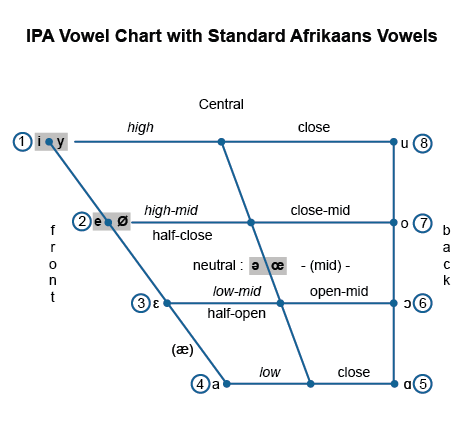
The formant frequencies as well as the temporal values of vowels vary per speaker based on age, gender, speech community, and also according to speech rate and style. Vowel duration as well as quality tends to reduce in rapid speech and in informal style, thus generally becoming shorter and tending in the direction of schwa.
In many cases /ø/ shows a strong tendency to unround, becoming [e], or near to [e], leading to the neutralisation of the distinction rounded: unrounded (Wissing 2011). Below we provide the formant values of /ø/ in its optimal production as a rounded vowel of Standard Afrikaans. These two front vowels share the formant frequency properties of a low F1 and a high F2. The [o] also has a low F1, but, by virtue of being a back vowel, is typified as having a low F2.
All three of these vowels are phonetically long. Average durations of 187 ms for /e/, 156 ms for /ø/ and 143 ms for /o/ were found for the SAfr. speaker mentioned-above, in the phonetic context /s_s/, read in a word-list style. Respective temporal values for coloured Afrikaans, using diverse phonetic contexts, but still in a word-list style are: 187 ms, 197 ms and 156 ms.
The following table and set of figures focus on the formant features of the three vowels [e], [ø] and [o]. Vowel information with respect to Standard Dutch (StD) was found in the description of Dutch in Taalportaal: Dutch.
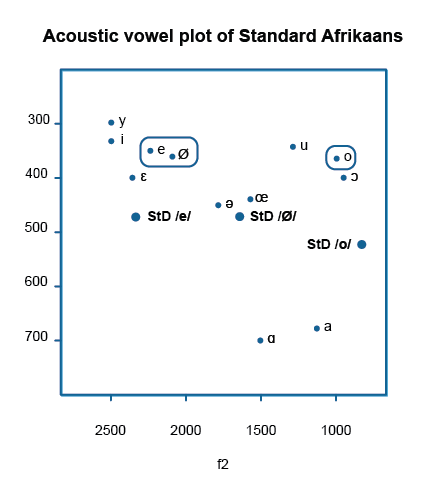
- The phonemes /e/ and /ø/ of Standard Afrikaans are in the green circle; /o/ is encircled in red. The Standard Dutch vowels are indicated by the abbreviation StD + /e/, /ø/ and /o/. The Afrikaans /e/ and /ø/ are situated in the mid-upper-left corner of the chart; corresponding closely to the articulatory mid-high front vowel position in Figure 1.
- While Dutch /ø/ is clearly positioned to the right of /e/, indicating a definite rounded quality for the former, this is not the case with Afrikaans' /ø/ in relation to its /e/. This difference is indicative of the less rounded pronunciation of /ø/ as marked rounded front vowel.
- The unrounded front vowel /e/ of SNdl., SAfr. and CAfr. are, with regards to F2, quite similar (resp. 2352 Hz, 2385 Hz and 2374 Hz), all the values being indicative of a front vowel. But there is a clear difference as to the F2 of the rounded /ø/ of the Afrikaans varieties on the one hand, and that of Dutch on the other. The low F2 of Dutch, 1690 Hz, is manifestly lower than the on average 2380 Hz of SAfr. and CAfr. (resp. 2385 Hz; 2374 Hz). This is indicative of very little roundedness of /ø/, while the /ø/ of Dutch is greatly rounded.
- The situation sketched in 3 is a very clear representative picture regarding the matter of roundedness in general in Afrikaans. Very similar other situations are found in the vowel system of Afrikaans where the feature Round is relevant, especially where this is the only distinctive feature e.g. in the vowel pairs /ə/ and /œ/, and /i/ and /y/.
First the waveforms and spectrograms of the two front vowels are presented in Figure 3, then that of /o/ in Figure 4.
Figure 3 shows the vowels /e/ and /œ/ as embedded in the nonsense context /s_s/, in this case sees and seus; Figure 4 is that of /o/.
Figure 3: Wave form (A) of the nonsense words /ses/ [siəs] and /søs/ [syœs], and their spectrograms (B).
| Sound | Sound waves and spectrogram |
 | Figure 3 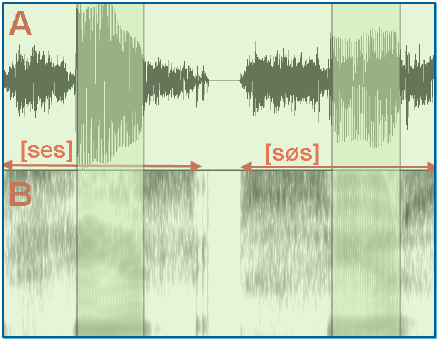 [click image to enlarge] |
Listen to the pronunciation of the two nonsense words that were used in producing the waveforms and the spectrograms.
Figure 4: Waveform (A) of the nonsense words /sos/ [suəs] and its spectrogram (B).
| Sound | Sound waves and spectrogram |
 | Figure 4 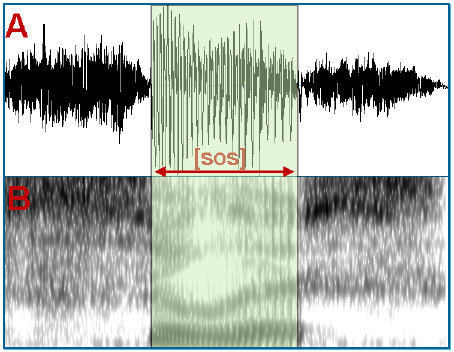 [click image to enlarge] |
In Figure 5 the formant tracks of /e/ and /ø/ are shown; in Figure 6 the formant tracks of /o/ are presented. The information concerning the formant tracks of these three vowels' movements are made more clear in Figure 6 by using arrows.
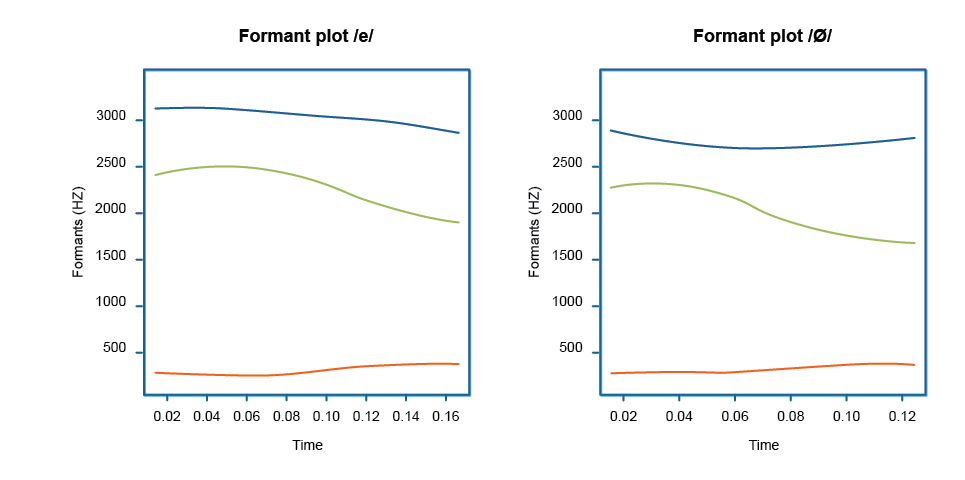
- F1 is the red track at the bottom of the figures, F2 is the green track (and F3 the black one at the top).
- The two patterns are very similar, although the portions above the red horizontal line show some differences.
- The gliding characteristics of both vowels are clear; the specific details of these are shown clearly in Figure 5.
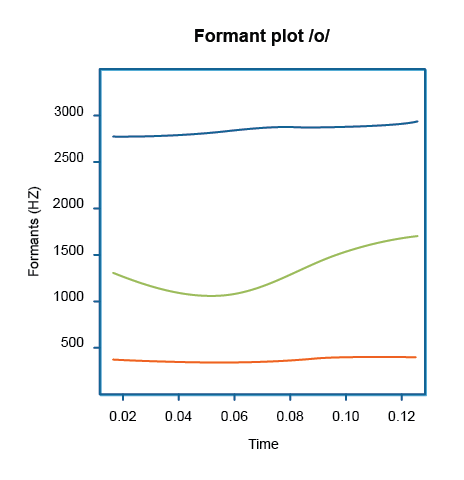
- For purposes of reference, schwa's position has been added. Note that the arrows of these vowels all tend in its direction.
- Here the gliding characteristics of both vowels are clear.
Being long, mid-high vowels, these three vowels share some specific phonological features. They are mostly stress attracting. Furthermore they all show variation with monophthongs in the form of vowel heightening and lowering, as explained in the following subsections. Read also Quality alternation of front vowels and Quality alternation of back vowels.
According to De Villiers and Ponelis (1987) /e/ and /o/ used to be hightened to a considerable degree in some regions of the Western Cape (They based their description on Van Rensburg (1981)). They state that hightening prodominantly occurs in open, single syllabled words (e.g. gee to give; nee no; see sea; tee tea; bo above; glo believe; so so) as well as preceding velar consonants as codas (e.g. leeg empty; weeg to weigh; bleek pale; smeek to beg; boog bow; hoog high; ook also; rook to smoke).
In Standard Afrikaans /e/ tends to alternate with /i/, especially when in generally unaccented positions, but also when unstressed due to morphological alternation, for example in eties /e.tis/ ['e.tis] ethical (adj.) > etiek /e.'tik/ [i.'tik] ethics, and also especially in conversations, starting with Weet jy... /vet jəi/ [vit jəi]; that is in contrast to the ending of an utterance: ... (jy) weet. /jəi vet/ [jəi viət].
The /o/ functions similarly ( /o/ > [u]) Pretoria /pre.'to.ria/ [pre.to.ri.ɑ] [pri.'to.ri.jɑ] (place name; noun) > Pretoriaans /pre.to.ri.'ans/ [pri.tu.ri.'ans] Pretorian (adj.). In this example an instance of /e/ > [i] is also present. The /ø/ > [y] or unrounded [i] is also possible: Europa /ø.'ro.pɑ/ [y/i.'ro.pɑ] Europa.
Note that in all cases the phonetic diphthongal variants may eventually be accepted as phonemic. That means that phonological transcriptions such as /e.tis/ will change to [iə.tis].
In similar conditions as pointed out in the case of heightening, /o/ and /e/ are lowered, respectively, to [ɔ] and [ɛ]. An example of /o/ > [ɔ] is in the first syllable of: professor /pro.'fɛ.sɔr/ > prof [prɔf] (abbrev. of professor). While the vowel of profeet /pro.fet/ (altermating with [u]) may be long [o], in the derived form professie it is more likely to lower to [ɔ].
Probably due to the scarcity of words with /ø/ as vowel, no cases of lowering exists.
Although nasalisation of all Afrikaans vowels has been a distinct characteristic of the vowel system for much of the previous century (cf. Le Roux and Pienaar 1927), it seems to be much less the case in recent years, especially in the speech of younger persons. Practically no evidence is found in coloured varieties, as is evident in the pronunciation of Genadendal Afrikaans speakers. Nasalisation is present in words with /e/, /ø/ and /o/ too, though on a lesser scale (Coetzee 1977). See also Nasalisation.
/e/: weens /vens/ [vẽ:s] due to
/ø/: Theuns /tøns/ [tø ~ :s] pers. name
/o/: Adoons /ɑ.dons/ [ɑ.'dõ:s] pers. name
The two commonly existing vowels, /e/ and /o/, are present in all syllable positions in Afrikaans, as nuclei in onsetless syllables as well as in t syllables preceded by at most three consonants. They may be followed by codas of up to three consonants, though not by CC clusters made up of two non-coronals such as in Dutch. Thus eend duck and oond oven but *eemp, *oomp .
- 1977Nasalering in Afrikaans.Tydskrif vir Geesteswetenskappe1728-46,
- 1987Afrikaanse fonologie.Macmillan
- 1987Afrikaanse klankleer.Tafelberg
- 1992Afrikaanse klankleer.Tafelberg
- 1927Afrikaanse fonetiek.Juta
- 1927Afrikaanse fonetiek.Juta
- 1981Aspekte van die verhoging van vokale in Afrikaans.Acta Academica. Reeks B2118-152,
- 2011Ontronding in Afrikaans / Derounding in Afrikaans.Tydskrif vir Geesteswetenskappe511-20,
- 2017FonologieVan Schaik
